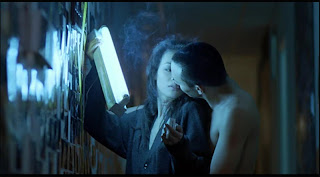
Because I bought the Masters of Cinema's Buster Keaton box set I am going to review all of his short films (1917-1923) during the next few weeks in 4 parts (one DVD at a time from the 4-DVD box). In the first part all of the films might be directed by Roscoe Arbuckle, but Buster Keaton has a strong presence in each film.
The Butcher Boy (1917) shows the core structure of what Arbuckle's films revolve around: the director's "greedy but lovable" character tries to win the love of a beautiful girl who is also courted by Al St. John's antagonistic bastard - and the whole story is full of slapstic comedy. In the first films Buster Keaton "only" gets unforgettable supporting roles. Even though the two setpieces of The Butcher Boys are funny and interesting the transition between them is ugly and some of the humor is unfunny because it is so lowbrow.

In The Rough House (1917) the same elements are mixed in a significantly more incoherent way that is worthy of a chuckle at best. The setting has changed from a general store to a big household which disappointing in comparison. The gags are still similar, but they come out of nowhere and don't add up into a hilarious sequence, which makes them cold. Or so it seems in comparison to other films Arbuckle and Keaton made. Nevertheless The Rough House is an enjoyable short film.

His Wedding Night (1917) is a tad slower than the other films in a way: the gags are more sparse and they are saved for the final third that is full of visual gags that are more or less funny. It's not exactly a great approach since the film doesn't work that well apart from its gags, but the comedy kicks more punch when you have to wait for it a bit longer than in the other films.

Oh, Doctor! (1917) follows a doctor who is seduced by a thief, but as the situation becomes more complicated a vicious amount of slapstick comedy dominates the film. For some reason the film is surprisingly dry even though it had the potential to be a lot better. It reminds me of The Rough House because my reaction was rather similar despite a superficially better screenplay.

Coney Island (1917) is clearly one of the better short films Arbuckle ever made. The amusement park section provides a bunch of classic and unforgettable gags. It is a shame the film takes a turn for more lowbrow humor in the end when it could have done so much more than that.

Out West (1918) is an interesting film for its time: it has (possibly accidental) anti-racist ideas that come through the parody of cliched tropes of the western film genre. This effort is more unified than Arbuckle's other films since it constantly makes fun of westerns in a refreshing way.

Out of the films I've seen so far The Bell Boy (1918) is the brightest result of the collaboration between Keaton, Arbuckle and St. John. The refined gags, top-notch acting and awesome setpieces guarantee success. There are moments that feel almost like subversion of established tropes in Arbuckle's films (such as St. John being one of the protagonists this time).

The final short film of this part, Moonshine (1918), hasn't completely survived to this day: only 6 minutes of the film have been found and released on DVD. As a result of that the short is more or less a mess that barely has the sort of brilliance you could expect from the makers.
In all of these films Keaton and Arbuckle perform magnificently in their heavily physical roles. Formally the films are stable and never distracting so I consider them successful in that regard as well.
Scores:
The Butcher Boy (1917): 8 out of 10
The Rough House (1917): 6 out of 10
His Wedding Night (1917): 7 out of 10
Oh, Doctor! (1917): 6 out of 10
Coney Island (1917): 8 out of 10
Out West (1918): 9 out of 10
The Bell Boy (1918): 9 out of 10
Moonshine (1918): 5 out of 10

























